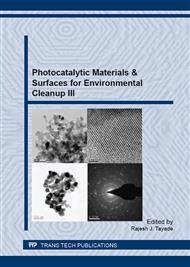[1]
D. Wei, P. Andrew, T. Ryhanen, Electrochemical photovoltaic cells – review of recent developments, J. Chem. Technol. Biotechnol. 85 (2010) 1547–1552.
DOI: 10.1002/jctb.2468
Google Scholar
[2]
D. Wei, G. Amaratunga, Photoelectrochemical cell and its applications in optoelectronics, Int. J. Electrochem. Sci. 2 (2007) 897–912.
Google Scholar
[3]
G. Hodes, J. Manassen, D. Cahen, Photoelectrochemical energy conversion and storage using polycrystalline chalcogenide electrodes, Nature 261 (1976) 403–404.
DOI: 10.1038/261403a0
Google Scholar
[4]
M. Gratzel, Conversion of sunlight to electric power by nanocrystalline dye–sensitized solar cells, J. Photochem. Photobiol. A 164 (2004) 3–14.
DOI: 10.1016/j.jphotochem.2004.08.014
Google Scholar
[5]
B. O'Regan, M. Gratzel, A low–cost, high efficiency solar cell based on dye–sensitized colloidal TiO2 films, Nature 353 (1991) 737–740.
DOI: 10.1038/353737a0
Google Scholar
[6]
C. Chen, M. Wang, J. Li, N. Pootrakulchote, L. Alibabaei, C. Ngoc–le, J. Decoppet, J. Tsai, C. Gratzel, G. Wu, S. Zakeeruddin, M. Gratzel, Highly efficient light–harvesting ruthenium sensitizer for thin–film dye–sensitized solar cells, ACS Nano. 3 (2009) 3103–3109.
DOI: 10.1021/nn900756s
Google Scholar
[7]
M. Gratzel, Photovoltaic and photoelectrochemical conversion of solar energy, Philos. Trans. Royal Soc. A 365 (2007) 993–1005.
Google Scholar
[8]
L. Liu, G. Wang, Y. Li, Y. Li, J. Zhang, CdSe quantum dot–sensitized Au/TiO2 hybrid mesoporous films and their enhanced photoelectrochemical performance, Nano Res. 4 (2011) 249–258.
DOI: 10.1007/s12274-010-0076-7
Google Scholar
[9]
S. Drouard, S.G. Hickey, J.D. Riley, CdS nanoparticle–modified electrodes for photoelectrochemical studies, Chem. Commun. 1 (1999) 67–68.
DOI: 10.1039/a808572b
Google Scholar
[10]
S. Ogawa, K. Hu, F.R.F. Fan, A.J. Bard. Photoelectrochemistry of films of quantum size lead sulfide particles incorporated in self–assembled monolayers on gold, J. Phys. Chem. B 101 (1997) 5707–5711.
DOI: 10.1021/jp970737j
Google Scholar
[11]
M.A. Mohammed, A.M. Mousa, J.P. Ponpon, Optical and optoelectric properties of PbCdS ternary films deposited by CBD, J. Semicond. Techn. Sci. 9 (2009) 117.
DOI: 10.5573/jsts.2009.9.2.117
Google Scholar
[12]
K.F. Cai, X.R. He. Hydrothermal synthesis and characterization of silver and antimony co–doped PbSe nanopowders, Mater. Letters. 60 (2006) 2461–2464.
DOI: 10.1016/j.matlet.2006.01.017
Google Scholar
[13]
P.P. Hankare, S.D. Delekar, V.M. Bhuse, K.M. Garadkar, S.D. Sabane, L.V. Gavali, Synthesis & characterization of chemically deposited PbSe thin films, Mater. Chem. Phys. 82 (2003) 505–508.
DOI: 10.1016/s0254-0584(03)00375-4
Google Scholar
[14]
P.P. Hankare, S.D. Delekar, M.R. Asabe, P.A. Chate, V.M. Bhuse, A.S. Khomane, K.M. Garadkar. Synthesis of cadmium selenide thin films at low temperature by chemical route & characterization, J. Phys. Chem. Solids. 67 (2006) 2506–25011.
DOI: 10.1016/j.jpcs.2006.07.006
Google Scholar
[15]
P.P. Hankare, S.D. Delekar, P.A. Chate, S. D. Sabane, K.M. Garadkar, V.M. Bhuse, A novel route to synthesize Cd1xPbxSe thin films from solution phase, Semicond. Sci. Techn. 20 (2005) 257–264.
DOI: 10.1088/0268-1242/20/3/001
Google Scholar
[16]
S.D. Delekar, M.K. Patil, B.V. Jadhav, K.R. Sanadi, P.P. Hankare, Synthesis and characterization of Cd0.7Pb0.3Se thin films for photoelectrochemical solar cell, Sol. Energy 84 (2010) 394–400.
DOI: 10.1016/j.solener.2009.12.009
Google Scholar
[17]
S. Gorer, A. Albu–Yaron, G. Hodes, Chemical solution deposition of lead selenide films: A mechanistic and structural study, Chem. Mater. 7 (1995) 1243–1256.
DOI: 10.1021/cm00054a027
Google Scholar
[18]
R.S. Mane, C.D. Lokhande, Chemical deposition method for metal chalcogenide thin films, Mater. Chem. Phys. 65 (2000) 1–31.
DOI: 10.1016/s0254-0584(00)00217-0
Google Scholar
[19]
V.L. Colvin, A.N. Goldstein, A.P. Alivisatos, Semiconductor nanocrystals covalently bound to metal surfaces with self assembled monolayers, J. Am. Chem. Soc. 114 (1992) 5221–5230.
DOI: 10.1021/ja00039a038
Google Scholar
[20]
S. Drouard, S.G. Hickey, J.D. Riley. CdS nanoparticle–modified electrodes for photoelectrochemical studies, Chem. Commun. 1 (1999) 67–68.
DOI: 10.1039/a808572b
Google Scholar
[21]
K. Hu, M. Brust, A.J. Bard. Characterization and surface charge measurement of self–assembled CdS nanoparticle films, Chem. Mater. 10 (1998) 1160–1165.
DOI: 10.1021/cm970757y
Google Scholar
[22]
M. Miyake, H. Matsumoto, M. Nishizawa, T. Sakata, H. Mori, S. Kuwabata, H. Yoneyama, Characterization of covalently immobilized Q–CdS particles on Au(111) by scanning tunneling microscopy and tunneling spectroscopy with high reproducibility, Langmuir 13 (1997) 742–746.
DOI: 10.1021/la960702v
Google Scholar
[23]
T. Nakanishi, B. Ohtani, K. Uosaki, Fabrication and characterization of CdS–Nanoparticle mono– and multilayers on a self–assembled monolayer of alkanedithiols on gold, J. Phys. Chem. B 102 (1998) 1571–1577.
DOI: 10.1021/jp973046w
Google Scholar
[24]
D. Liu, P. Kamat. Photoelectrochemical behavior of thin cadmium selenide and coupled titania/cadmium selenide semiconductor films, J. Phys. Chem. 97 (1993) 10769–10773.
DOI: 10.1021/j100143a041
Google Scholar
[25]
R.D. Gould, B.B. Ismail, The formation of Schottky barriers on evaporated cadmium telluride thin films using aluminium electrodes, J. Mater. Sci. Lett. 11 (1992) 313–314.
DOI: 10.1007/bf00729166
Google Scholar
[26]
H. Gerischer, in Topics in Applied Physics, in: B. O. Seraphin, Ed., Solar Energy Conversion, vol. 31, Springer–Verlag, Berlin, 1979.
Google Scholar
[27]
G.S. Shahanea, K.M. Garadkar, L.P. Deshmukh, Structural, optical and electrical properties of indium doped CdS0.9Se0.1 thin films, Int. J. Electron. 51 (1997) 246–251.
DOI: 10.1016/s0254-0584(97)80313-6
Google Scholar
[28]
A.M. Al–Dhafiri, A.A.I. Al–Bassam, The mechanism of the oxygen annealing in gold surface barriers on CdSxSe1−x devices, Sol. Eng. Mater. Sol. Cells, 33 (1994) 177–182.
DOI: 10.1016/0927-0248(94)90206-2
Google Scholar
[29]
J.F. McCann, R.C. Kainthla, M. Skyllas–Kazacos. Chemical deposition of Cd1–xHgxS thin film electrodes for liquid–junction solar cells, Sol. Ener. Mater. 9 (1983) 247–251.
DOI: 10.1016/0165-1633(83)90047-3
Google Scholar
[30]
A. Iwase, A. Kudo, Photoelectrochemical water splitting using visible–light–responsive BiVO4 fine particles prepared in an aqueous acetic acid solution, J. Mater. Chem. 20 (2010) 7536–7542.
DOI: 10.1039/c0jm00961j
Google Scholar
[31]
M.A. Butler, Photoelectrolysis and physical properties of the semiconducting electrode WO2, J. Appl. Phys. 48 (1977) 1914–1920.
DOI: 10.1063/1.323948
Google Scholar
[32]
D.S. Ginley, M.A. Butler, The photoelectrolysis of water using iron titanate anodes, J. Appl. Phys. 48 (1977) 2019–2021.
DOI: 10.1063/1.323911
Google Scholar
[33]
P.K. Mahapatra, A.R. Dubey, Photoelectrochemical behaviour of mixed polycrystalline n–type CdS–CdSe electrodes, Sol. Ener. Mater. Sol. Cells 32 (1994) 29–35.
DOI: 10.1016/0927-0248(94)90253-4
Google Scholar
[34]
R.N. Noufi, P.A. Kohl, A.J. Bard, Semiconductor electrodes, XV. Photoelectronche– mical cells with mixed polycrystalline n–type CdS–CdSe electrodes, J. Electrochem. Soc. 125 (1978) 375–379.
DOI: 10.1149/1.2131453
Google Scholar
[35]
G. Keiser. Optical Fiber Communications 3rd Ed., McGraw–Hill, McGraw–Hill Inc., New York, 2000.
Google Scholar
[36]
F.C. Allard, Fiber Optics Handbook: For Engineers and Scientists, McGraw–Hill Inc., New York, 1990.
Google Scholar


